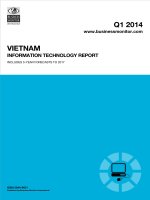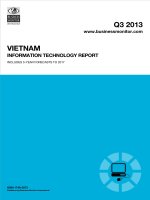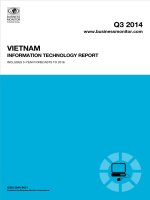United states information technology report q3 2014
Bạn đang xem bản rút gọn của tài liệu. Xem và tải ngay bản đầy đủ của tài liệu tại đây (581.34 KB, 98 trang )
Q3 2014
www.businessmonitor.com
UNITED STATES
INFORMATION TECHNOLOGY REPORT
INCLUDES 5-YEAR FORECASTS TO 2018
ISSN 2042-4205
Published by:Business Monitor International
United States Information
Technology Report Q3 2014
INCLUDES 5-YEAR FORECASTS TO 2018
Part of BMI’s Industry Report & Forecasts Series
Published by: Business Monitor International
Copy deadline: June 2014
Business Monitor International
Senator House
85 Queen Victoria Street
London
EC4V 4AB
United Kingdom
Tel: +44 (0) 20 7248 0468
Fax: +44 (0) 20 7248 0467
Email:
Web:
© 2014 Business Monitor International
All rights reserved.
All information contained in this publication is
copyrighted in the name of Business Monitor
International, and as such no part of this
publication may be reproduced, repackaged,
redistributed, resold in whole or in any part, or used
in any form or by any means graphic, electronic or
mechanical, including photocopying, recording,
taping, or by information storage or retrieval, or by
any other means, without the express written consent
of the publisher.
DISCLAIMER
All information contained in this publication has been researched and compiled from sources believed to be accurate and reliable at the time of
publishing. However, in view of the natural scope for human and/or mechanical error, either at source or during production, Business Monitor
International accepts no liability whatsoever for any loss or damage resulting from errors, inaccuracies or omissions affecting any part of the
publication. All information is provided without warranty, and Business Monitor International makes no representation of warranty of any kind as
to the accuracy or completeness of any information hereto contained.
CONTENTS
BMI Industry View 7
SWOT 9
IT SWOT 9
SWOT 11
Political 13
Economic 14
Business Environment 15
Industry Forecast 16
Table: IT Industry - Historical Data And Forecasts (United States 2011-2018) 16
Broadband 20
Table: Telecoms Sector - Internet - Historical Data & Forecasts 20
Macroeconomic Forecasts 22
Table: United States - Gdp By Expenditure 28
Industry Risk Reward Ratings 30
Table: Americas Risk/Reward Ratings, Q3 2014 32
Market Overview 33
Hardware 33
Software 38
Services 44
Industry Trends And Developments 48
Regulatory Development 52
Table: IT Regulatory Authorities 52
Competitive Landscape 54
Local Companies 54
Table: CA Technologies 54
Table: Splunk 55
Table: Symantec 56
Table: EMC Corporation 57
Company Profile 58
Hewlett-Packard 58
Dell 65
Microsoft Corporation 71
IBM 78
Table: IBM Acquisitions, 2012 (Total Value, USD3.964bn) 81
Table: IBM Recent Acquisitions 81
United States Information Technology Report Q3 2014
© Business Monitor International Page 4
Regional Overview 85
Demographic Forecast 89
Table: The United States' Population By Age Group, 1990-2020 ('000) 90
Table: The United States' Population By Age Group, 1990-2020 (% of total) 91
Table: The United States' Key Population Ratios, 1990-2020 92
Table: The United States' Rural And Urban Population, 1990-2020 92
Methodology 93
Industry Forecast Methodology 93
Sources 94
Risk/Reward Ratings Methodology 95
Table: It Risk/Reward Ratings Indicators 96
Table: Weighting Of Components 97
United States Information Technology Report Q3 2014
© Business Monitor International Page 5
BMI Industry View
BMI View: The outlook for US IT spending is strong relative to the majority of developed markets over the
medium term, as a result of stronger economic performance and a greater appetite from enterprises for the
latest products and solutions. Cloud computing, real-time enterprise software, security and big data are all
areas of spending in which we expect to see rapid growth, particularly in the latter years of our forecast.
the retail hardware outlook is more mixed, as we expect continued demand growth for tablets in the retail
market; however, desktop and notebook sales continue to be squeezed. There is also potential for deeper
fiscal retrenchment to hit government IT spending. The NSA PRISM scandal continues to produce fallout
amid concerns about data security in the cloud computing market. Total spending is expected to reach
USD665bn in 2014, up 5.3% from 2013, and grow at a CAGR of 4.4% 2014-2018.
Headline Expenditure Projections
■
Computer Hardware Sales: USD217bn in 2013 to USD225bn in 2014, an increase of 3.8%. Booming
tablet sales are driving growth, but there is a boost to desktop sales in 2014 due to the withdrawal of
official support for XP in April 2014, pushing upgrades.
■
Software Sales: USD173bn in 2013 to USD184bn in 2014, an increase of 6.2%. Emerging technologies
such as machine-to-machine and big data are being adopted by enterprises, while demand for cyber
security solutions is also an area of growth.
■
IT Services Sales: USD242bn in 2013 to USD257bn in 2014, an increase of 6.4%. Cloud computing
adoption is already high in the US but we expect strong growth to continue over the medium term despite
security concerns following on from the NAS Prism debacle.
Key Trends & Developments
In 2014 IBM reaffirmed its commitment to a strategy that will see it focus on higher value software and
services. In January 2014 IBM agreed the sale of its x86 server business to Chinese PC vendor Lenovo for
USD2.3bn. The deal includes System x, BladeCenter and Flex System blade servers and switches, x86-
based Flex integrated systems, NeXtScale and iDataPlex servers and associated software, blade networking
and maintenance operations. The deal is expected to close in 2014, subject to regulatory approval, and
would dramatically increase Lenovo's exposure to the US server market, and reducing IBM's exposure to
the lower margin server hardware business.
There was an interesting twist in approach at Microsoft following the strategic shift enacted after the
departure of CEO Steve Ballmer. In June 2014 Microsoft and Salesforce.com entered into a partnership
agreement in order to create new services that link Salesforce's CRM apps and platform to Microsoft Office
United States Information Technology Report Q3 2014
© Business Monitor International Page 7
and Windows software. The deal comes despite Microsoft also selling its own enterprise software services
through the Azure brand, reflecting the new direction taken after the departure of Steve Ballmer as CEO.
Under the terms of the deal, both the firms intend to offer various services, such as Salesforce1 for
Windows and Windows Phone 8.1, and Salesforce for Office 365. The financial terms of the deal have not
been released.
United States Information Technology Report Q3 2014
© Business Monitor International Page 8
SWOT
IT SWOT
SWOT Analysis
Strengths
■
The largest IT market in the world, with spending forecast to reach about USD783bn
in 2018.
■
The US is the largest centre of global IT innovation, home to many leading hardware,
software and services vendors.
■
Meanwhile most non-US global firms also have a research and retail presence.
■
Despite the challenging trading conditions, overall IT spending is still expected to
remain in positive growth territory.
■
PC shipments have held up better than in other developed markets in 2013 and are
forecast to do so in 2014.
Weaknesses
■
In the wake of the recession and subsequent slow economic recovery, customers
have postponed IT investments and reduced short-term spending, particularly in
areas such as consulting and software development.
■
Desktop and notebook sales appear to be in long-term decline due to longer
replacement cycles and the preference for mobile devices including tablets,
smartphones, smart TVs and convertibles/hybrids.
Opportunities
■
Technologically savvy local population willing to spend on premium devices, with the
US a particularly strong market for Apple's iPad and MacBooks.
■
As economic woes ease, IT vendors should see more growth from traditional big-
spending sectors such as banks, financial services, retail and manufacturing.
■
Microsoft support of Windows XP ceased in Q214, which should accelerate desktop
replacements and OS upgrades.
■
Potential for growth in the hardware market through form factor evolution ie ultra-thin
notebooks, hybrids/convertibles and tablets.
United States Information Technology Report Q3 2014
© Business Monitor International Page 9
SWOT Analysis - Continued
■
Cloud computing, with a large number of federal and state cloud computing
programmes generating opportunities.
■
Growth from emerging technologies such as Big Data and machine-to-machine
communications will drive innovation and spending.
Threats
■
Privacy and cyber security became more pressing issues with the PRISM spying
revelations. This is expected to damage US cloud computing providers abroad, but
domestic impact is uncertain.
■
The large federal budget deficit could lead to pressures on public sector IT spending.
United States Information Technology Report Q3 2014
© Business Monitor International Page 10
SWOT
SWOT Analysis
Strengths
■
A large proportion of households continue to have a fixed-line connection.
■
Broadband growth remains robust despite a declining fixed-line market and
fluctuating pay-TV subscriptions.
■
Demand for faster speeds is leading to new technologies being introduced by
operators.
■
Connect America Fund is seeking to expand coverage.
Weaknesses
■
Fixed-line decline has been happening for over a decade. In 2013 it has been faster
than anticipated and no real respite is expected.
■
Even in cases of fixed-line subscriber growth, revenue and minutes of use are both
down.
■
Sluggish growth in broadband penetration despite high levels of public sector
investment.
■
Despite Obama's USD7.2bn investment in improving broadband connectivity,
deployment has been slow and a significant proportion of the population remains
underserved.
■
New technologies such as WiMAX and LTE will cannibalise fixed broadband market.
Opportunities
■
Wireline broadband continues to offer faster download speeds than wireless options,
making it more attractive prospect for many clients.
■
Broadband growth remains steady, if unspectacular, and the relatively low
penetration rate means it should continue in this vein.
■
IPTV growth highlights opportunities for operators to bring subscribers over a single
network offering considerable cost savings.
United States Information Technology Report Q3 2014
© Business Monitor International Page 11
SWOT Analysis - Continued
Threats
■
Problems in US economy are driving subscribers to mobile substitution faster than
ever, leading to a faster decline as subscribers look to reduce their outgoings.
■
LTE means the fixed broadband market will become increasingly redundant.
■
Weaker dollar has made the cost of contracts higher from external vendors.
■
Consolidation is likely to occur as Charter Communications aggressively reviews
takeover targets.
United States Information Technology Report Q3 2014
© Business Monitor International Page 12
Political
Political SWOT Analysis
Strengths
■
The US is an undisputed superpower and therefore occupies centre stage in most
international diplomacy.
■
A long-standing democracy with vigorous and open political debate, the US
continues to attract large numbers of immigrants committed to citizenship and self-
advancement.
Weaknesses
■
Political debate between Republicans and Democrats has historically been polarised
and divisive.
■
As today's superpower, the US attracts the enmity of a wide range of political groups
opposed to the current international status quo.
Opportunities
■
The widespread dissatisfaction of the voting public with the performance of Congress
may encourage both major parties to experiment with more consensual approaches
to certain policy areas.
Threats
■
The perception of inflexibility and bias in US foreign policy, particularly in the Middle
East, may stiffen opposition and at worst provide fertile recruiting ground for radical
anti-US groups such as al-Qaeda. Partly as a reaction to foreign policy difficulties, US
public opinion may return to an isolationist and protectionist mode.
United States Information Technology Report Q3 2014
© Business Monitor International Page 13
Economic
Economic SWOT Analysis
Strengths
■
The world's largest economy, with an impressive record of entrepreneurial dynamism
and innovation, and high research and development spending.
■
Despite some threats to its reserve status, the US dollar is treated as an international
currency, meaning investors around the world are prepared to hold US debt. Because
of this, the US is uniquely able to run large fiscal and current account deficits.
Weaknesses
■
Despite the dollar's role as an international currency, excessive US debt levels are a
risk. A decision by the Japanese and Chinese central banks to reduce their larger
dollar holdings could cause sharp falls in the value of the US currency.
■
A low savings rate by US households on a historic basis, although this has begun to
reverse.
Opportunities
■
Further liberalisation of international trade through the WTO, coupled with a more
competitive dollar exchange rate, could boost export growth and help restore balance
to the US's external imbalances.
Threats
■
Intensified competition from China and other low-wage economies could accelerate
the loss of manufacturing jobs.
■
Long-term budget imbalances, if left unaddressed, could eventually require an abrupt
cut back in spending that would weigh on economic growth.
United States Information Technology Report Q3 2014
© Business Monitor International Page 14
Business Environment
SWOT Analysis
Strengths
■
The US boasts the world's largest single internal consumer market, which presents
tremendous opportunities for businesses of all types and sizes.
■
Few countries offer a better environment for entrepreneurial activity, with a highly
flexible labour force, a legal system that is friendly to business, and significant centres
of technological innovation (such as California's Silicon Valley).
Weaknesses
■
Much of the physical infrastructure is in need of improvement, with congested roads
and airways.
■
US corporate tax is, on average, among the highest in the OECD (though effective
taxes are much lower).
Opportunities
■
The US has often been the origin of new drivers of economic growth booms, and
sectors ranging from biotechnology to alternative energy are being discussed as
possible catalysts.
Threats
■
The US's chronic fiscal deficits may force the federal government to find ways to raise
effective corporate tax rates, following a multi-decade downtrend.
United States Information Technology Report Q3 2014
© Business Monitor International Page 15
Industry Forecast
Table: IT Industry - Historical Data And Forecasts (United States 2011-2018)
2011 2012 2013e 2014f 2015f 2016f 2017f 2018f
IT market value,
USDmn
571,674.9 595,113.6 632,248.7 665,568.2 697,049.6 725,628.6 753,637.9 783,180.5
IT market value, % of
GDP
3.7 3.7 3.8 3.8 3.8 3.8 3.8 3.7
Computer hardware
sales, USDmn
201,388.7 206,837.6 216,753.9 225,021.5 232,352.6 238,422.6 244,035.9 249,871.6
Personal computer
sales, USDmn
163,527.7 169,606.8 179,472.2 186,317.8 192,387.9 197,413.9 202,061.7 206,893.7
Software sales,
USDmn
153,780.6 161,573.3 173,236.1 184,029.6 194,476.8 204,264.5 214,033.2 224,381.2
Services sales,
USDmn
216,505.7 226,702.7 242,258.7 256,517.2 270,220.2 282,941.6 295,568.8 308,927.7
e/f - BMI estimate/forecast. Source: BMI.
BMI forecasts the US IT market will expand by 5.3% in 2014 to reach a value of USD665.6bn. Our
positive outlook extends over the medium term and we forecast a CAGR of 4.4% 2014-2018, with total
spending expected to reach USD783bn in 2018. Despite the maturity of the IT market in the US, we believe
there is medium-term growth potential in sales of tablets and hybrid notebooks in the retail market, while in
the enterprise market adoption of cloud computing, big data and machine-to-machine (M2M)
communications will drive growth.
United States Information Technology Report Q3 2014
© Business Monitor International Page 16
2014 Outlook
US IT market growth will be sustained in 2014 by
the supportive economic environment. When
compared with its developed market peers, the US
market is expected to continue to perform well. US
economic growth for 2014 is forecast at 2.4% in real
terms, while private final consumption is forecast to
increase even faster at 2.9%. These growth rates are
a positive for the retail hardware market as rising
incomes and progress made by consumers in
deleveraging boosts confidence.
One area to watch in 2014 is the competition
between hybrid notebooks running Microsoft
Windows 8/8.1 and tablets, lead by Apple's iPad.
The US market is dominated by Apple's advertising,
store and brand reach, with the iPad a must-have
item among affluent consumer groups. However,
with hybrid prices declining there is potential for Microsoft to make some in-roads in the ultra portable
market. There may also be a boost to desktop sales after Microsoft ceased support for Windows XP in
Q214. Traditionally conservative business consumers will be forced to undertake operating system
upgrades.
In contrast to a recovery in consumer and enterprise spending government expenditure is forecast to
contract 0.5% in real terms in 2014. However, one area of public sector spending that will continue to grow
is cloud services, for which there are expected to be many more contracts with the continued
implementation of the federal government of its Cloud First cloud migration strategy. Departments such as
the US General Services Administration are already making significant use of cloud services, as the
government seeks to make savings in its USD80bn IT budget. The recession may have had a lasting impact
on the IT market by encouraging consideration of cloud computing models such as software-as-a-service
(SaaS).
Finally, enterprise spending on IT should experience moderate growth in 2014 as confidence begins to
return. However, while there is pent-up demand from projects delayed as a result of the economic situation,
Industry Trends - IT Market
2011-2018
e/f - BMI estimate/forecast. Source: BMI.
United States Information Technology Report Q3 2014
© Business Monitor International Page 17
some of this may not now be realised. The growing market for cloud solutions and virtualisation will
constrain demand for on-premises computer networks. Regardless of the exact strength and nature of the
recovery, the current economic environment will offer some opportunities to vendors.
The economy will be generally supportive over the
medium term, particularly when compared against
other developed markets. Real GDP growth is
forecast to average 2.4% annually 2014-2018, with
consumption growth expected to be slightly slower
at 2.2%. However, BMI's in-house Country Risk
breakdown of income growth by income level shows
that the gains will largely be captured by the highest
earning 20% of the population. This bodes well for
vendors of premium hardware, for instance Apple,
but the outlook for sales growth of mid-range
devices is less positive.
Investments in supporting infrastructure will boost
IT market spending over the medium term. Telecom
operator investments in mobile and fixed broadband
infrastructure will help to boost retail sales of
hardware, particularly mobile PCs such as tablets and hybrids/convertibles. These investments also enable
adoption of cloud computing services by consumers and small and medium-sized enterprises (SMEs) that
are not in large urban areas already served by high-quality telecoms infrastructure.
There are also technology trends that will drive growth. BMI has a bullish view for the development of the
M2M market, or Internet of Things, which is a medium-term opportunity for IT software and service
providers to partner with telecoms operators. For instance, in 2013 leading software and services firms,
including SAP and Wipro, partnered with M2M communications providers to tap growth in the nascent
market. US mobile operators are among the global leaders in the deployment of M2M services, with
verticals such as utilities, security, asset tracking, vehicle infotainment and other smart services targets for
growth. We believe software and services firms will benefit either though partnerships with operators or by
selling to them direct.
Income Per Capita Breakdown
(2011-2018)
Poorest 20%, net income per capita, USD
Richest 20%, net income per capita, USD
Middle 60% of population, net income per capita, USD
2011 2012 2013e 2014f 2015f 2016f 2017f 2018f
20,000
40,000
60,000
0
e/f - BMI estimate/forecast. Source: BMI, National Sources
United States Information Technology Report Q3 2014
© Business Monitor International Page 18
Another technology trend is the adoption of cloud computing services, with surveys showing high levels of
satisfaction with cloud services among US CIOs, reflecting the fact it is already the world's leading cloud
market. This means growth opportunities are relatively diminished compared to emerging markets, but
vendors will drive value growth by rolling out more customised solutions and targeting SMEs. However
there is some uncertainty, with the enterprise response to the fallout from the NSA Prism scandal not yet
clear.
Segments
The government remains a key end-user despite pressure on fiscal expenditure. Federal IT spending reached
a level of around USD80bn as departments continue to issue IT tenders despite a drive to make savings
through closing hundreds of federal datacentres in 2012-2015. New government programmes, including the
expansion of healthcare, should generate lucrative new opportunities for IT vendors, although because of
the ever-growing budget deficit, there will be increased pressure to reduce costs.
With economic growth now underway, IT vendors should experience more growth from traditionally big-
spending sectors such as banking, financial services, retail and manufacturing. BMI expects financial
services will be a key spending vertical as new regulations require increased investment, and in addition, the
increasing cyber security threat facing them will force further investment in services and solutions. The
advent of mobile payment systems will be an additional source of spending growth.
Small businesses are also a target for vendors. There are more than 8mn small businesses in the US, which
is a substantial market. However, there are significant differences between the needs of businesses in
different industries. Increasingly, vendors will need to customise approaches based on industry-specific
needs.
Summary
The hardware market is predicted to grow from USD225bn in 2014 to USD249bn in 2018. Software
spending should rise from USD184bn to USD224bn, and IT services from USD257bn to USD309bn, over
the forecast period.
United States Information Technology Report Q3 2014
© Business Monitor International Page 19
Broadband
Table: Telecoms Sector - Internet - Historical Data & Forecasts
2011 2012 2013e 2014f 2015f 2016f 2017f 2018f
No of Internet Users ('000) 218,965 236,503 249,389 256,090 266,784 271,529 273,973 276,164
No if Internet Users/100 Inhabitants 69.53 74.49 77.92 79.39 82.06 82.86 82.96 82.97
No of Broadband Internet Subscribers
('000) 84,870 91,668 97,038 99,646 103,807 106,066 107,021 107,877
No of Broadband Internet Subscribers/100
Inhabitants 26.95 28.87 30.32 30.89 31.93 32.37 32.40 32.41
e/f = BMI estimate/forecast. Source: BMI, FCC
New data from the FCC show there were 91.668mn fixed broadband subscribers in the US at the end of
2012, alongside 170.076mn mobile broadband subscribers. The FCC's definition of broadband uses data
transfer rate benchmarking that is not wholly consistent with that employed elsewhere in the world.
Nevertheless, it is clear from the FCC's data that the most significant growth in broadband is in the wireless
arena and that, as has been seen in other mature markets worldwide, the greater flexibility of mobile relative
to fixed connections is causing some xDSL customers to 'cut the cord'.
The fixed broadband market remains buoyant mainly due to cable and fixed wireless usage, which remains
strong, as well as to a small but growing base of fibre accesses. BMI forecasts the number of fixed
broadband connections to reach 99.6mn by the end of 2014, rising to 107.9mn by 2018.
High-speed internet is central to the marketing strategies of telecoms operators, with cable companies and
mobile operators pursuing the high revenue area. At the same time, the sheer popularity of internet-based
services means that the point is fast approaching when most Americans will view such services as being
essential to their daily lives. The Broadband Technologies Opportunities Program backs up this view and
efforts to extend broadband services into rural areas will ensure that this trend continues, particularly as
service providers and content developers/vendors grow their product portfolios and become more adept at
marketing and pricing content that appeals to a broad range of consumers. Similarly, the FCC's National
Broadband Plan aims to ensure universal access, competition and the efficient allocation of spectrum to
benefit the broadband sector. Increased revenue derived from such activities will allow operators to expand
into new markets and it seems increasingly likely that fixed-line operators will need to become broadband-
focused in order to survive.
United States Information Technology Report Q3 2014
© Business Monitor International Page 20
Industry Trends - Internet
2011-2018
Internet users, '000 Broadband internet subscribers, '000
2011
2012
2013e
2014f
2015f
2016f
2017f
2018f
0
100,000
200,000
300,000
0
20,000
40,000
60,000
80,000
100,000
120,000
e/f = BMI estimate/forecast. Source: BMI. Operators, FCC
United States Information Technology Report Q3 2014
© Business Monitor International Page 21
Macroeconomic Forecasts
BMI View: We expect a strengthening US consumer and stronger fixed investment growth this year to boost
real GDP growth to 2.8% from 1.9% in 2013. While high frequency data suggest economic growth slowed
in Q114, we expect that the slowdown was largely weather-related, with signs suggesting that its impact on
the economy has already begun to dissipate.
Macro Outlook: Despite a fairly weak start to the year across a range of macroeconomic indicators, we
maintain our forecast for US real GDP growth to accelerate to 2.8% in 2014 from 1.9% in 2013. We see
much of the slowdown recorded in the early months, when the Institute for Supply Management's (ISM)
Manufacturing Index took a decided turn lower, as attributable to extreme cold weather conditions in much
of the country, rather than the beginning of a major slowdown in economic activity across the US. While we
acknowledge that Q114 real GDP growth may be quite weak, we expect that particularly strong household
spending at the end of 2013 will carry into this year, spurring fixed investment growth, while stronger
external demand buoys net exports, and the drag from government fiscal retrenchment dissipates.
Slowdown Will Prove Temporary
US - Real GDP Growth, SAAR % chg & ISM Manufacturing Index (3-Month MA)
Source: FRED, BMI
United States Information Technology Report Q3 2014
© Business Monitor International Page 22
Expenditure Breakdown:
Private Consumption: We expect several factors to coincide this year, resulting in personal consumption
expenditure (PCE) growth being the primarily driver of US growth. First, we expect further tightening in
the labour market this year (see 'Additional Gains For Labour Market In 2014', April 1) and sustained home
price increases to buoy consumer confidence, ensuring it remains at or near post-financial crisis highs. The
Conference Board Consumer Confidence Index hit 82.3 in March, the highest level since January 2008,
while the University of Michigan Index of Consumer Sentiment came in at 80.0, fairly elevated compared
to recent years and consistent with strong PCE growth in the months ahead.
High Confidence Levels Will Support Spending Growth
US - Consumer Confidence Indicators
Source: Bloomberg, BMI
Moreover, while income growth has trended lower in recent quarters (
see chart below), we believe the
combination of higher consumer sentiment, improving household net worth due to rising home prices, and
several years of consumer deleveraging will facilitate stronger consumption this year, potentially due to an
uptick in consumer credit. Indeed, the household debt-to-income ratio has fallen from a high of 114.5% in
United States Information Technology Report Q3 2014
© Business Monitor International Page 23
Q109 to 91.6% in Q413, the lowest level since Q302. As a result of these factors, we forecast real PCE
growth will accelerate to 2.5% in 2014 from 2.0% last year.
Consumer Credit May Make Up For Lower Trending Income Growth In
Recent Years
US - Personal Income Growth, % chg y-o-y (LHS) & Household Debt, % Of Personal Income (RHS)
Source: Bloomberg, BMI
Fixed Investment: A downturn in capital goods orders suggests that Q114 may see a fairly weak real fixed
investment growth print (see chart below), but we generally view this as a temporary disruption that will
yield to accelerating fixed investment in the remainder of the year. While our infrastructure team expects to
see a slowdown in residential construction growth, we believe that non-residential fixed investment will
more than pick up the slack. Mainly, we believe that signs of resurgent US consumer demand will drive
business investment substantially higher, as will a more supportive external environment. Additionally, we
believe greater clarity regarding fiscal and debt policy in 2013 will allow the private sector to make
investments that they likely put on hold last year amidst a highly contentious policy debate that led to the
shutdown of the federal government in October 2013. We forecast real fixed investment growth of 6.5%
this year, up from 4.5% in 2013.
United States Information Technology Report Q3 2014
© Business Monitor International Page 24
Consumer & External Demand Will Bolster Investment After Q1 Slump
US - ISM Manufacturing Capital Goods Orders (3-Month MA) & Real Non-residential Fixed Investment
Growth, SAAR % chg
Net Exports: While both real exports and imports of goods and services grew by less than forecast last
year, the general trend of exports growing faster than imports was in line with our expectations, resulting in
net exports adding 0.1 percentage points (pp) to headline growth. In 2014, we anticipate that stronger
economic activity in developed markets, particularly in Europe and Canada, will increase demand for US
goods and service exports, which we forecast will post real growth of 3.6% this year after 2.5% in 2013.
While strong real PCE growth will increase import demand, we expect that this will be tempered a
structural reduction in demand for energy imports, the result of several years of massive crude oil
production increases in the US that our Oil and Gas team believes will continue this year, albeit at a slower
pace. We forecast real growth of goods and services imports will tick up to 1.8% this year after growth of
just 1.4% in 2013. As a result, we forecast net exports to contribute 0.2pp to real GDP growth this year.
United States Information Technology Report Q3 2014
© Business Monitor International Page 25









